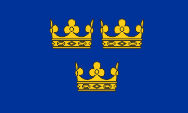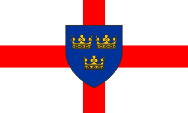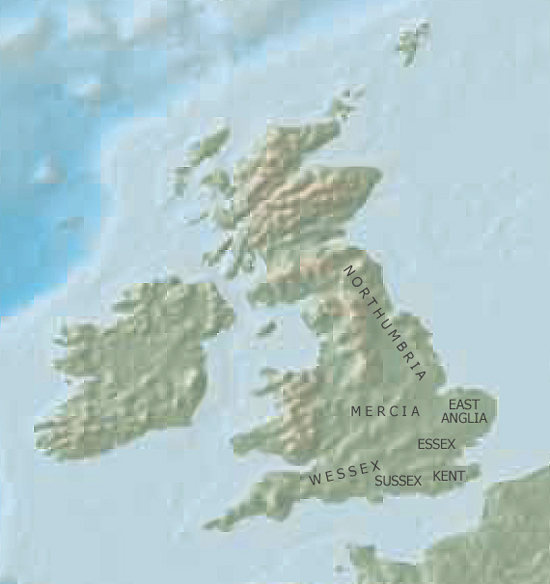mobile View, to the German Version tap the flag


- East Anglia
- former lingdom in south eastern England
- own name: Ēast Engla Rīce
• Introduction
• History
• Flag
• Meaning/Origin of the Flag
• Map
Britannia was conquered by Roman legions around the year 43 and became in 85 a province of the Roman Empire. Towards the end of the fourth century the Roman Empire came under considerable pressure from outside, so that Britannia could no longer be held. Thus the Romans began to withdraw about 400 or 410. Shortly afterwards, Jutes and Angles began to migrate in eastern and southern Britannia coming from today's Denmark and Saxons coming from the area of the Weser and Elbe estuaries, and also some Frisians. The differences between the peoples blurred over the generations, and they were summarized under the term Anglo-Saxons. As fighters they have been very welcome for the mostly Romanesque Celtic British, against the since the withdraw of the Romans advancing Picts and Scots. Already in the middle of the fifth century, they had established themselves as the new aristocracy and began to separate from themselves by the formation of their own kingdoms.
Since the beginning of the 6th century, seven great kings have been known which dominated the south and east of Britannia. A formation of states that has become known in history as "Heptarchy" (Greek: hepta = seven). These have been the kingdoms of Sussex, Wessex, Essex, Kent, East Anglia, Mercia and Northumbria. However, in reality, there have been more and some smaller kingdoms, which, however, often existed for only a short time. In 825 Wessex, Sussex, Kent and Mercia became united under King Egbert of Wessex. Essex, East Anglia and parts of Mercia were occupied by invading Danes in the year 865 and became summarized as "Danelaw" (Danelag, territory of Danish law). In 1016 the Danish Knut the Great (brother of the king of Denmark) forced his election to the first king of England. After riots the Danish rule ended in 1050, and in 1066 Harald II., Earl of Wessex, was crowned to the first Anglo-Saxon King of England.
Source: Wikipedia (D)

The kingdom of East Anglia was probably founded around 520 by Wehha, the first king. It was established by the people of the Angles, and was placed in the east of Britannia. Other tribes of the Angles established other kingdoms in the inner and northern Britannia, so that the name "East Anglia" is self-explanatory. In the middle of the 7th century East Anglia came under the influence of the neighboring kingdom of Mercia. After that was come under the rule of Wessex in 825, East Anglia also became dependent on Essex. From the middle of the 9th century onwards, Viking tribesmen frequently invaded, who finished the East Anglian kingship. In 879 started a settlement by Danes, who set the kings from 880. In 917 East Anglia was re-conquered from the Danes by Edward the Elder, King of Wessex, and it became little afterwards an English county. Today it consists essentially of two counties, Norfolk and Suffolk. These names are very old, older than the East Anglia itself, and they refer to two different settlement areas, that of the northern people and that of the southern people.
Source: Wikipedia (D)


Flag of East Anglia,
ratio = 3:5,
Source, by: Wikipedia (EN)




today's flag of East Anglia,
ratio = 3:5,
Source, by: Wikipedia (EN)






The heraldry of East Anglia, which is known today, shows a blue central shield with three golden crowns, layed upon on a red, English St. George's cross. The blue shield with the three crowns seems to have been handed over, and should have already been used at the beginning of the seventh century, as it can be seen in descriptions. In stone, however, it appears for the first time around 1400 in the church of Saxmundham. The addition by the St. George's was made at the end of the 19th century, when George Henry Langham created the present flag in 1902. The three crowns are coincidentally reminiscent to Sweden or the Danish-dominated Kalmar Union.
Source: Wikipedia (EN), Volker Preuß


Source: Freeware, University of Texas Libraries, modyfied by: Volker Preuß


![]()









